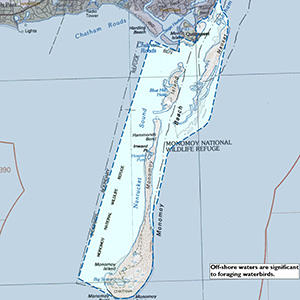Important Bird Area Sites in Massachusetts
Important Bird Area: Monomoy and South Beach NWR
Site Summary
Nominated By
Blair Nikula
Size
3,000+ acres
Towns and Counties
Chatham; Barnstable
Ownership
US Fish and Wildlife Service, municipal
Major Habitats
coastal beach 60%, marine/tidal 20%, salt marsh <20%, lake/pond <5%
Land Use
undeveloped
Serious Threats
predators
IBA Criteria
- Category 1: Sites important for long-term research and/or monitoring projects that contribute substantially to ornithology, bird conservation, and/or education.
- Category 2: Raptors: The site is a bottleneck or migration corridor for more than 5,000 migratory raptors during a migration season.
- Category 5: Waterfowl: The site regularly supports 500 or more waterfowl at any one time. The designation "waterfowl" includes birds such as loons, grebes, cormorants, geese, ducks, coots, and moorhens.
Site Description
This IBA includes barrier beach/ islands, with 25+ miles of coastline-primarily dunes and tidal flats and some fresh/brackish wetlands (ponds, cattail marsh, some boggy depressions). The lighthouse on South Monomoy is on the National Register of Historic Places.
Current Conservation Status
Monomoy is a federally designated Wilderness Area, the only such area in southern New England. Human usage is increasing and becoming a problem in some cases. Extensive areas of Monomoy are closed during the breeding season, fenced, and patrolled by the US Fish and Wildlife Service. Nesting sites of Piping Plovers and terns on South Beach are monitored by Mass Audubon. Horseshoe Crab harvesting may affect migrant shorebirds (several species that feed on Horseshoe Crab eggs). The situation is being studied and restrictions are being implemented.
Ornithological Significance
The barrier beach and other habitats support breeding populations of the federally listed Piping Plover and Roseate Tern, and state listed Northern Harrier, Common Tern, and Least Tern (formally also the Pied-billed Grebe, Arctic Tern, and Short-eared Owl). Also recorded have been the transient federally listed Bald Eagle and Peregrine Falcon (formally the Eskimo Curlew and state-listed Common Loon). Six breeding and six transient regional high conservation priority species are found at this site. Lesser numbers of a variety of transient passerines and raptors use the area as a stopover during migration, and significant numbers of transient and wintering sea ducks (Common Eidesr and all three scoter species numbering into the ten of thousands; Red-breasted Mergansesr and Long-tailed Ducks occasionally 1,000+) have been observed. Freshwater ponds often host 1,000+ waterfowl in the fall, with regionally significant numbers of American Black Ducks, Northern Pintails, Blue-winged Teal, Green-winged Teal, Gadwalls, Northern Shovelers, American Wigeons, Ruddy Ducks, and American Coots (all of the dabbling ducks breed in varying numbers). Numbers of migrant shorebirds routinely exceed 5,000 birds in the spring and 10,000 birds in the fall, with globally significant numbers of the Hudsonian Godwit in the fall. The breeding population of Snowy Egrets has recently ranged from 28 to 75+ pairs and Black-crowned Night-Herons exceed 100 pairs. Research projects include long-term monitoring of terns, 25 years of ISS shorebird census, American Oystercatcher research in the 1980s, Short-eared Owl studies in the 1980s, and Piping Plover research in the 1990s.
Other Flora or Fauna of Significance
This is one of the largest haul-out sites for Gray Seals and Harbor Seals in the Northeast as well as being a significant breeding site for Horseshoe Crabs. South Monomoy has been chosen as a site to reintroduce the threatened Northeast Beach Tiger Beetle.
Data Sources
International Shorebird Surveys, USFWS data, Mass Audubon data, Blair Nikula personal records.




